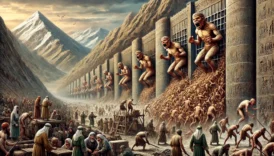Babylon: The Gate of the Gods and the Lost Civilization
In the heart of Mesopotamia, a city once stood: Babylon. It was one of the greatest civilizations in history, home to the first written laws, early advancements in astronomy, and remarkable architectural wonders. The city’s legacy includes the Hanging Gardens, one of the Seven Wonders of the Ancient World, the legendary Tower of Babel, and magnificent palaces. However, Babylon was also seen as a city cursed by the wrath of God, making it a symbol of both glory and downfall.
- Babylon: The Gate of the Gods and the Lost Civilization
- The Origins of Babylon: The Birth of a Civilization
- The Hanging Gardens of Babylon: Myth or Reality?
- How Were the Hanging Gardens Built?
- The Tower of Babel: A Monument to Human Ambition
- Babylon's Contributions to Science and Knowledge
- The Fall of Babylon: The End of an Empire
- Reasons for Babylon’s Fall
- Saddam Hussein’s Babylon and the Modern Era
- 2003 Iraq War and the Destruction of Babylon
- Conclusion
The Origins of Babylon: The Birth of a Civilization
The name Babylon means “Gate of the Gods” and first appeared in Akkadian texts. However, its foundation dates back even further, likely to the Sumerian period. The Sumerian name for the city, “Kadira,” also translates to “Gate of the Gods.”
Before becoming a dominant power, Babylon was just another city-state under Sumerian rule. In 2300 BCE, the Akkadian king Sargon conquered Babylon and made it part of his empire. However, the city’s true rise to power came with King Hammurabi in the 18th century BCE.
During Hammurabi’s reign, Babylon became the largest and most powerful city in Mesopotamia. Throughout history, many different peoples ruled over Babylon: Amorites, Akkadians, Chaldeans, Assyrians, and Persians. However, the city’s golden age occurred under the Chaldean dynasty. With its opulent palaces, advanced agricultural systems, and scientific achievements, Babylon became the cultural and intellectual center of the ancient world.
The Hanging Gardens of Babylon: Myth or Reality?
One of Babylon’s greatest mysteries is the Hanging Gardens. As one of the Seven Wonders of the Ancient World, these gardens are considered a marvel of ancient engineering.
According to legend, King Nebuchadnezzar II built the gardens for his wife, Queen Amytis. The queen, originally from Media (modern-day Iran), missed the green mountains of her homeland, so the king decided to create a paradise in the middle of the desert.
How Were the Hanging Gardens Built?
- An advanced irrigation system transported water from the Euphrates River to the gardens.
- Multiple terraces were stacked on top of each other, filled with exotic plants, trees, and flowers.
- The gardens were designed to withstand Babylon’s hot and dry climate.
- A sophisticated water-lifting mechanism was used to sustain the greenery at high levels.
However, Babylonian texts make no mention of the Hanging Gardens. Additionally, no archaeological evidence has been found to confirm their existence. Some historians believe the gardens were merely a myth, while others suggest they were actually built in Nineveh, the Assyrian capital.
The Tower of Babel: A Monument to Human Ambition
One of Babylon’s most legendary structures was the Tower of Babel. According to biblical accounts, humans attempted to build a tower to reach the heavens, defying God. In response, God punished them by scattering them across the earth and confusing their languages.
The Tower of Babel was reconstructed by Nebuchadnezzar II in the 6th century BCE and was believed to be about 90 meters (300 feet) high. The tower had seven tiers, each symbolizing different aspects of the universe:
- Earth
- Fire
- Plants
- Animals
- Humans
- The Sky
- Angels and the Divine Realm
Babylonians believed that climbing the tower would bring them closer to their god, Marduk. However, due to multiple invasions and destructions, the tower was eventually abandoned.
Babylon’s Contributions to Science and Knowledge
Babylon was not only famous for its architectural wonders but also for its advancements in science, mathematics, and literature. Many of the fundamental systems we use today were first developed in Babylon.
- The first numerical system based on a sexagesimal (base-60) system was created here. This system is still used today in measuring time and angles.
- The first lunar calendar was invented in Babylon.
- Babylonians made significant progress in astronomy and astrology, creating detailed star maps and tracking celestial movements.
- The first written laws, Hammurabi’s Code, were established here. These laws followed a “law of retaliation” principle, ensuring punishments matched the crime.
The Fall of Babylon: The End of an Empire
Despite its greatness, Babylon eventually declined. The city was conquered by the Persian Empire in 539 BCE, marking the end of its dominance. However, unlike other conquests, the Persians did not destroy Babylon but instead integrated it into their empire.
Later, Alexander the Great planned to make Babylon the capital of his vast empire. However, he died in the city before he could complete his plans. After his death, Babylon lost its importance and gradually faded into history.
Reasons for Babylon’s Fall
- Continuous military invasions
- Economic decline and agricultural failures
- The shifting course of the Euphrates River
- Religious and political turmoil
By the Middle Ages, Babylon was forgotten, buried under layers of sand and time. It wasn’t until the 19th century that archaeologists rediscovered its ruins.
Saddam Hussein’s Babylon and the Modern Era
In the late 20th century, Iraqi President Saddam Hussein attempted to restore Babylon. He saw himself as the modern heir to Babylon’s legacy and ordered reconstruction projects to revive the city’s former glory.
2003 Iraq War and the Destruction of Babylon
- During the Iraq War, Babylon suffered significant damage from American and coalition forces.
- Ancient structures were repurposed as military bases, causing irreversible harm.
- Many archaeological artifacts were stolen or destroyed.
In 2019, Babylon’s ruins were designated as a UNESCO World Heritage Site. However, the city still bears the scars of war and destruction.

Conclusion
Babylon was a city of unparalleled greatness, a center of knowledge, and a symbol of human ambition. However, it was also seen as a city that challenged the gods and ultimately paid the price.
Despite its downfall, Babylon’s contributions to science, law, architecture, and literature continue to shape the modern world. The city, once filled with towering temples and vast palaces, may have crumbled into dust, but its legacy remains immortal.





